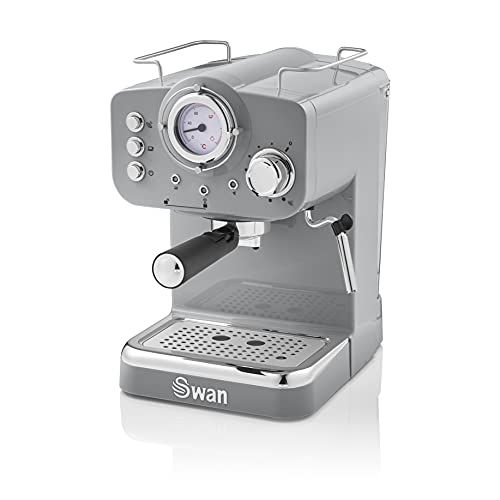What to Look For in a Commercial Espresso Machine
When buying a commercial coffee machine, there are a variety of factors to take into account. best home espresso machine of espresso machine that is ideal for your establishment will depend on the amount and purpose of use and barista's abilities.
Double boiler systems offer the capability to brew and steam simultaneously. This decreases the time it takes to recover between pulls. Proportional-integral-derivative (PID) temperature control manages on/off cycles for optimal boiler temperatures.
Productivity
A commercial espresso machine can handle a greater volume of coffee than a home machine. The idea of allowing a home espresso machine to perform in a professional setting could be an invitation to disaster.
A high quality commercial machine can serve up to 100 cups of coffee per hour at peak times. This can be a lifesaver for busy workplaces, stopping employees from having to stand around for their coffee. their coffee.
A coffee maker can aid workers in bonding. Teams of people often have coffee in a rotating manner for each other, which can facilitate collaboration and teamwork within the workplace. A coffee bar can help new employees feel more comfortable at work and break down the barriers between them, the senior employees and other employees.
Commercial espresso machines come in a variety of sizes to meet different requirements. Some models are entirely automated while others are able to program espresso shots in advance so that operators do not need to guess the correct size of each shot. This is particularly crucial for businesses that have untrained baristas as inaccurate shots can greatly impact the intensity and flavor of espresso. It is also advisable to buy commercial espresso machines that are made of ethically-sourced materials that support the communities in which coffee beans are cultivated. This will ensure that the product is of high quality and minimize the negative impact to the environment.
Safety
Espresso machines are big, heavy pieces of equipment that can cost as much as a brand-new compact car. They're also designed to crank out hundreds of shots and drinks over the course of an entire day. Commercial espresso machines pose unique health and safety risks for employees due to their high production.
It's important to keep it in mind that commercial espresso machines are likely to run on warm water, which could aid in the growth of bacteria. A machine that is not maintained properly and hasn't been cleaned or descaled regularly can start to build up spent espresso, which may become rancid and cause illness if consumed by customers. A commercial espresso machine with a steam wand that is not sealed could allow bacteria to thrive in the milk foaming process.
When choosing an espresso machine for commercial use, it is important to think about the type of beverages you'll be serving and how many cups per hour your space can handle. You'll also want to find an espresso machine with automated features, which make it easier and faster to serve your patrons their favorite coffee drink. Also, look for a guarantee that covers parts and labor, so that any technical issues are resolved quickly and efficiently.

Energy Efficiency
Commercial espresso machines require considerably more power than the home models. Professional espresso machines are more heavy and come with larger boilers to accommodate multiple group heads in regular cafe production. They also operate at a higher temperature in the ambient and are typically located in an indoor space (such as the cafe or restaurant) where the electronics may quickly overheat, resulting in malfunctioning machines.
The boiler of an espresso machine designed for commercial use heats and stores water that has been pressurized by an electric pump. This water is used to brew and steam espresso. The boiler is made up of a number of copper tubes that are heated by electric elements. When the brew level sensor senses that the water has reached its goal level the solenoid valve will open to let the boiler fill with fresh water. The heating element is turned off.
There are four types of espresso machines. They differ by the way they steam or brew: TX (brewing-only), TX (twin-boilers) HX (double automated), and DA (double automated). TB and TX machines provide stable brewing temperatures, while DA can provide rapid steaming using one boiler. HX machines are used by many cafes as they provide the highest quality in steam and brew temperature.
Maintenance
Like cars that require regular tune-ups commercial espresso machines require regular maintenance to function smoothly and efficiently. If you keep your machine in good condition and you are able to enjoy a better-tasting coffee and it will last longer.
It's a daily ritual to clean your espresso machine, but you should pay attention to the parts that need more thorough cleaning. There will be leftovers from coffee grounds and other milk products that could cause the machine to fail over time. Regular cleaning will keep your espresso machine in great condition.
The majority of commercial espresso machines require descaling every three months. This procedure requires a few additional steps in comparison to regular cleaning. It is recommended to review the manual to ensure that you adhere to all the guidelines. The solution used to descal the water tank dissolves the scale. In order to complete this process it is necessary to put a container under the steam wand, and in certain models, under the coffee spouts. Follow the guidelines for your model.
A water filter change is another maintenance task. This is a step that can be overlooked but is important to keep in mind so you don't get a build-up of mineral deposits. Check for calcification, which is difficult to get rid of in the spray head.
